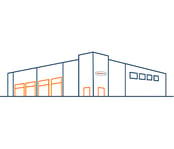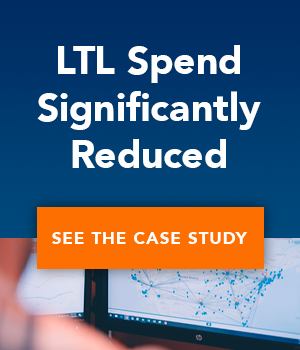When searching for logistics services, it can be difficult to decipher which specific services you need, much less which company to choose. Whether you pick and choose certain supply chain services or go all in and have everything consolidated under one provider, many businesses look to a third-party logistics (3PL) provider like ODW Logistics.
3PLs are best positioned to deliver cost savings and continuity. We have the expertise, resources, and perhaps most importantly, the relationships, to provide reliable logistics services that allow you to focus on your core business. Outsourcing logistics can help you scale your business and manage growth effectively. Without your supply chain in order, you run the risk of late or missed deliveries, leading to frustrated customers.
So, what are logistics services, anyway? Rather than offer a broad definition, let us walk you through the ins and outs of logistics, and how they're separated out into various services. That way, you can get an idea of which services might suit your needs.
Supply Chain Design
We are in an age of reimagining supply chains to be more resilient and efficient. Supply chain design can create cost savings that simply aren't attainable with patchwork to a flawed process. Throughout the process of supply chain design, we're able to provide a personalized approach that leads to optimal solutions.
What does supply chain design include? We typically start with location selection to identify the ideal geographic location for distribution based on your customer base and cost comparison modeling. If you have a national customer base, a location like Columbus, Ohio, for example, reaches 90 percent of the U.S. within two days of transportation. Likewise, if your customer base is largely in the Northeast and/or Midwest, Columbus puts you within a 10-hour drive of 46 percent of the U.S. population, including cities such as New York, Philadelphia, Boston, and Chicago.
Alongside location selection, we conduct a transportation network analysis (which we'll discuss in greater detail on its own below). In short, a transportation network analysis looks at your current transportation network and alternative solutions to optimize carriers, mode selection and other factors that can lead to cost savings. Then, we move on to engineered warehouse solutions for your fulfillment needs. Designing a distribution center involves layout, design, process mapping, and warehouse automation technology. Many businesses can benefit from warehouse automation by outsourcing logistics services. If you truly want to invest in your supply chain for the long haul, supply chain design enables strategic decision making from the ground up. Learn more about supply chain design. Supply Chain design also includes several additional services that tend to flow into a larger design, but can be executed singly as well.
Mode and Carrier Selection
A subset of supply chain design, determining which carriers can move your freight most reliably and efficiently is one of the most essential logistics services. The key to mode and carrier selection is to first determine the right mix of carriers, brokers, and other dedicated assets based on the nature of your business. Then, it's time to negotiate rates and get carriers signed on. From there, it's a matter of managing the transportation network, with an eye on key performance indicators (KPIs).
Few businesses have the time, personnel, and relationships to choose the right carriers and manage them in the day to day. 3PLs live and breathe logistics. In the process, they build great relationships. ODW has a fully vetted network of 30,000-plus carriers at the ready. With so many options to choose from, we can select the best fits for your business and maintain strategic partnerships that get you the best price and service.
Transportation Network Analysis
As part of supply chain design, a transportation network analysis looks at where you are right now to determine the best route to get where you want to go with your supply chain. It's a key piece in many of our best success stories, enabling us to make recommendations that balance cost, speed, and quality for optimal transportation and cost savings. If you're just looking at any one of those three elements, you are likely sacrificing one or both of the others. A transportation network analysis can help answer important questions that you might not have even thought to ask, such as, “How many distribution points should I use?” and “Where should those nodes be located?”
A transportation network isn't confined to transportation. It also brings warehousing and inventory into the picture for a holistic view of your logistics, all tying back to how decisions will impact your customer. If you're operating many warehouses, we may also recommend a more focused warehouse network analysis. Read our cover feature in Parcel Magazine, “The Art of a Network Analysis.”
Contract Logistics (aka Dedicated Warehousing)
Contract logistics can include a broad array of services, generally centered around a long term agreement of 3+ years for a dedicated warehouse. While you may either own or rent the physical location, the management and operations of that warehouse are supported by a 3PL including labor, technology, capital equipment, and other services.
These longer term agreements are often built for your operation, meaning how your warehouse is designed, supported, and continues to evolve is based on your specific needs. Further, an experienced 3PL will be able to bring proactive solutions for problems or needs that you may not be expecting. We'll describe some of those solutions below.
E-Commerce Fulfillment
Direct-to-consumer (D2C) logistics is a very different animal compared to business-to-business (B2B) and wholesale shipments. Consumers expect brands to provide fast and free shipping that's on time, every time—
Wondering what to look for in an e-commerce fulfillment provider? Speed to market, industry expertise, agility, location, and warehouse technology are the main differentiators.
Don't forget about reverse logistics services, either. No matter how great your product may be, returns happen. Especially if you're making the standard e-commerce promise of easy returns and complete satisfaction or money back, you need a return strategy. And finally, your e-commerce fulfillment should be scalable, whether for seasonal spikes, overall growth, or both. Read more about e-commerce fulfillment from ODW, operating 29 distribution centers across the U.S.
Manufacturing Support Logistics
Just like e-commerce brands have unique logistics challenges, so do manufacturers. Manufacturing support logistics services can help a manufacturer reduce labor, improve efficiency, shorten lead times, and strengthen their supply chain all at once. Especially key to supporting manufacturing, the right 3PL can help you optimize inventory management and labor costs. With varied product catalogs and parts coming from multiple sources, many manufacturers utilize just-in-time (JIT) inventory management, meaning parts are delivered in synchronization with production. This system, however, if not planned intentionally, or managed proactively can be rife with inefficiencies. Re-evaluating your provisioning methods and considering things like line-side delivery can help keep your production line running smoothly. We also provide packaging and labeling before coordinating and managing the transportation of your products to customers.
One of the most important aspects of manufacturing support logistics, especially when outsourcing logistics to a 3PL, is visibility. You need to be able to see where any given item may be on any given day. We provide this visibility through intuitive Andon visual technology that makes real-time updates readily available. With outsourced logistics in place and a dedicated team to call on any time, you can keep your operations lean and streamlined. See our seven-step approach to manufacturing support logistics.
Transportation Management
Another major advantage of a 3PL is that they can provide you with transportation management. However, before considering what services can benefit you, you may be wondering what the differences are between a full-service transportation management provider and a freight broker.
Fundamentally, a transportation management provider is a strategic partner who will work with you to optimize management of your transportation operations. A freight broker usually helps you scale shipments, communicating between shippers and a large network of carriers to ensure your products are getting to their endpoints safely and efficiently.
While not exclusively the case, 3PLs act more as transportation management providers. They offer all of the services of freight brokers, but include other strategic services to optimize your logistics operation.
Load Optimization
Small and mid-sized businesses can work with a 3PL to optimize their freight from a packing standpoint. Load optimization is one of the proven ways to reduce shipping costs and one of the key benefits of outsourcing your transportation management. Using sophisticated software, a 3PL will know which modes to choose and how to pack items as tightly as possible for full truckloads. They will match up the items you're shipping based on dimensions, weight, and handling requirements to maximize utilization and reduce mileage, in turn reducing shipping costs.
Freight Consolidation
With optimized loads for all clients, we can then consolidate those loads into the most efficient truckloads possible. Freight consolidation, also sometimes referred to by 3PLs as multi-client consolidation, can improve customer satisfaction, increase consistency in your supply chain, and allow your business to scale, all while creating cost savings.
Consolidated freight is an effective solution for reducing LTL spend, which can often quietly rise when not monitored. For example, a large paper food packaging manufacturer saw its LTL rates increase by 31 percent in a six-month span with its previous 3PL provider. ODW was able to immediately negotiate more favorable LTL rates through its vast carrier network. We then leveraged load optimization and freight consolidation to make the savings last. See additional freight consolidation case studies and read our introduction to freight consolidation.
If your business is struggling with LTL rates and shipping times, freight consolidation can be a major problem solver that you've been missing. Alongside efficiency, freight consolidation also addresses sustainability by reducing the number of trucks on the road.
Vendor Scorecarding
Vetting any given carrier is only the beginning of the working relationship with them. To set the partnership up for success, we need to establish KPIs, measure performance, and keep in constant communication. Vendor scorecards create the accountability needed to ensure a carrier is delivering on its promises. However, if you're accustomed to selecting carriers simply based on cost, you won't necessarily know what KPIs to include on a scorecard and may not feel comfortable introducing and managing a scorecarding program. A 3PL is the ideal intermediary to keep your carriers honest and on their toes.
Carrier decisions are frequently in flux, especially for businesses that need to keep logistics costs in check to maintain their bottom line. Vendor scorecards give you a clear track record of performance that you can use to make proactive and confident decisions. Read more about the advantages to carrier scorecarding.
Carrier Procurement
Outsourcing logistics to a 3PL isn't just about leveraging their carrier network; it's about establishing a “network within the network” of carriers that work well with your business. Carrier procurement involves designing, monitoring, and adjusting your carrier network to meet the needs of your freight, maximize savings, and drive performance. Like many logistics services, procurement could account for an entire department within your operations—but with a 3PL, you get an extension of your team without having to manage them in-house. We also use the most advanced technology without you having to invest in software or train staff. And remember, procurement isn't just a matter of finding the lowest cost. We must balance cost with speed and quality to select the best overall carriers for your freight.
Claims Management
Even with optimal logistics, claims are inherent to moving freight. When products are lost or damaged, it can be difficult and time-consuming to navigate the claims process. If you're working with one carrier and a small volume of freight, it may be feasible to keep claims management in-house—but if you're working with multiple carriers and daily shipments, the paperwork and communications become consuming, and then there are the damaged shipments themselves to take in while you're trying to get orders out. Because of the sheer headache, claims management is one of the most common supply chain services that companies outsource for faster resolutions and recoveries.
Find the Right Logistics Services for Your Business
Now that you have a better understanding of the different types of logistics services available, you can feel more comfortable speaking the language of logistics with 3PLs and narrowing down to the services you need.
ODW Logistics
Since 1971, we’ve been providing warehousing, distribution, and transportation solutions for hundreds of brands. We operate as an extension of your business to control costs throughout your supply chain that deliver you a competitive advantage over your competition.RECENT POSTS
Streamlining Your Supply Chain for Maximum Efficiency Navigating the Complexities of Modern Grocery Retail The supply ch...
Dec. 03, 2024 09:13 AM
ODW Logistics is expanding its Columbus operations with a newly designed, state-of-the-art distribution campus. This adv...
Nov. 26, 2024 09:41 AM
Columbus, Ohio—2024 — Food Logistics, the only publication exclusively dedicated to covering the movement of product thr...
Oct. 21, 2024 10:52 AM








.png)

